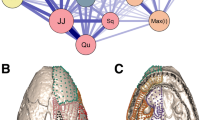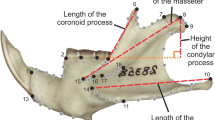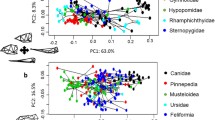Abstract
The mammalian cranium is a complex structure composed by three partially independent modules: face, cranial base and cranial vault. At the same time, it interacts with the mandible by sharing the masticatory function. Since these units develop and work together, their function and evolution may occur through correlated changes. Here, we assessed the patterns of evolutionary shape variation and covariation (i.e. integration) of cranial modules and mandible among the highly ecomorphologically diverse caviomorph rodents, and the potential evolutionary consequences on the morphological evolution of this clade. Three-dimensional geometric morphometrics was used to describe cranio-mandibular shape. The phylogenetic signal and evolutionary allometric component of morphometric variables were analyzed; in addition, evolutionary covariation among cranial modules and mandible was assessed using phylogenetic comparative methods. Significant phylogenetic signal and evolutionary allometry were detected. Large covariance values, involving coordinated breadth increase as the main shape change, were recorded between cranial vault and base, followed by cranial vault and face, and face and mandible. Since the basicranium may be the main cranial integrator, the overall widening of the cranial base, derived from the enlargement of the auditory bullae, could be influencing the integrated evolution of skull. In caviomorphs, the cranio-mandibular morphological evolution would be the outcome of a tight covariation among the modular units, and this could be driven by several factors such as allometry and specializations to environmental niches.










Similar content being viewed by others
References
Ackermann, R. R., & Cheverud, J. M. (2004). Morphological integration in primate evolution. In M. Pigliucci & K. Preston (Eds.), Phenotypic integration: Studying the ecology and evolution of complex phenotypes (pp. 302–319). Oxford: Oxford University Press.
Adams, D. C. (2014). A generalized K statistic for estimating phylogenetic signal from shape and other high-dimensional multivariate data. Systematic Biology, 63(5), 685–697.
Adams, D. C., & Otarola-Castillo, E. (2013). Geomorph: An R package for the collection and analysis of geometric morphometric shape data. Methods in Ecology and Evolution, 4(4), 393–399.
Álvarez, A., Perez, S. I., & Verzi, D. H. (2011). Ecological and phylogenetic influences on mandible shape variation of South American caviomorph rodents (Rodentia: Hystricomorpha). Biological Journal of the Linnean Society, 102(4), 828–837.
Álvarez, A., Perez, S. I., & Verzi, D. H. (2013). Ecological and phylogenetic dimensions of the cranial shape diversification in South American caviomorph rodents (Rodentia: Hystricomorpha). Biological Journal of the Linnean Society, 110(4), 898–913.
Blomberg, S. P., Garland, J. T., & Ives, A. R. (2003). Testing for phylogenetic signal in comparative data: Behavioral traits are more labile. Evolution, 57(4), 171–745.
Bookstein, F. L., Gunz, P., Mitteroecker, P., Prossinger, H., Schaefer, K., & Seidler, H. (2003). Cranial integration in Homo: Singular warps analysis of the midsagittal plane in ontogeny and evolution. Journal of Human Evolution, 44(2), 167–187.
Candela, A. M., & Picasso, M. B. J. (2008). Functional anatomy of the limbs of Erethizontidae (Rodentia: Caviomorpha): Indicators of locomotor behavior in Miocene porcupines. Journal of Morphology, 269(5), 552–593.
Cardini, A., & Elton, S. (2008). Does the skull carry a phylogenetic signal? Evolution and modularity in the guenons. Biological Journal of the Linnean Society, 93(4), 813–834.
Cardini, A., & Polly, P. D. (2013). Larger mammals have longer faces because of size-related constraints on skull form. Nature Communications,. doi:10.1038/ncomms3458.
Cardini, A., Polly, P. D., Dawson, R., & Milne, N. (2015). Why the long face? Kangaroos and wallabies follow the same ‘rule’ of cranial evolutionary allometry (CREA) as placentals. Evolutionary Biology,. doi:10.1007/s11692-015-9308-9.
Cheverud, J. M. (1982). Phenotypic, genetic, and environmental morphological integration in the cranium. Evolution, 36(3), 499–516.
Cheverud, J. M. (1996). Developmental integration and the evolution of pleiotropy. American Zoologist, 36(1), 44–50.
Cornette, R., Baylac, M., Souter, T., & Herrel, A. (2013). Does shape co-variation between the skull and the mandible have functional consequences? A 3D approach for a 3D problem. Journal of Anatomy, 223(4), 329–336.
Drake, A. G., & Klingenberg, C. P. (2010). Large-scale diversification of skull shape in domestic dogs: Disparity and modularity. The American Naturalist, 175(3), 289–301.
Eisenberg, J. F., & Redford, K. H. (1999). Mammals of the Neotropics. Vol. 3: the Central Neotropics—Ecuador, Peru, Bolivia, Brazil. Chicago: University of Chicago Press.
Elissamburu, A., & Vizcaíno, S. F. (2004). Limb proportions and adaptations in caviomorph rodents (Rodentia: Caviomorpha). Journal of Zoology London, 262(2), 145–159.
Emerson, S. B., & Bramble, D. M. (1993). Scaling, allometry, and skull design. In J. Hanken & B. K. Hall (Eds.), The skull: Functional and evolutionary mechanisms (pp. 384–421). Chicago: University of Chicago Press.
Felsenstein, J. (1985). Phylogenies and the comparative method. American Naturalist, 125(1), 1–15.
Goswami, A. (2006). Cranial modularity shifts during mammalian evolution. American Naturalist, 168(2), 270–280.
Goswami, A., & Polly, P. D. (2010). The influence of modularity on cranial morphological disparity in Carnivora and Primates (Mammalia). PLoS ONE, 5(3), e9517.
Goswami, A., Polly, P. D., Mock, O. B., & Sánchez-Villagra, M. R. (2012). Shape, variance and integration during craniogenesis: Contrasting marsupial and placental mammals. Journal of Evolutionary Biology, 25(5), 862–872.
Goswami, A., Smaers, J., Soligo, C., & Polly, P. D. (2014). The macroevolutionary consequences of phenotypic integration: From development to deep time. Philosophical Transactions of the Royal Society B, 369(1649), 20130254.
Hafner, J. C., & Hafner, M. S. (1988). Heterochrony in rodents. In M. L. McKinney (Ed.), Heterochrony in evolution: A multidisciplinary approach (pp. 217–235). New York: Plenum Press.
Hallgrímsson, B., Jamniczky, H., Young, N. M., Rolian, C., Parsons, T. E., Boughner, J. C., & Marcucio, R. S. (2009). Deciphering the palimpsest: Studying the relationship between morphological integration and phenotypic covariation. Evolutionary Biology, 36(4), 355–376.
Hallgrímsson, B., & Lieberman, D. E. (2008). Mouse models and the evolutionary developmental biology of the skull. Integrative and Comparative Biology, 48(3), 373–384.
Hallgrímsson, B., Lieberman, D. E., Liu, W., Ford-Hutchinson, F. A., & Jirikc, F. R. (2007a). Epigenetic interactions and the structure of phenotypic variation in the cranium. Evolution & Development, 9(1), 76–91.
Hallgrímsson, B., Lieberman, D. E., Young, N. M., Parsons, T., & Wat, S. (2007b). Evolution of covariance in the mammalian skull. In G. Bock, & J. Goode (Eds.), Tinkering: The microevolution of development (pp. 164–187). Chichester: Wiley (Novartis Foundation Symposium 284).
Hautier, L., Lebrun, R., & Cox, P. G. (2012). Patterns of covariation in the masticatory apparatus of hystricognathous rodents: Implications for evolution and diversification. Journal of Morphology, 273(12), 1319–1337.
Klingenberg, C. P. (2009). Morphometric integration and modularity in configurations of landmarks: Tools for evaluating a priori hypotheses. Evolution & Development, 11(4), 405–421.
Klingenberg, C. P. (2010). Evolution and development of shape: Integrating quantitative approaches. Nature Reviews Genetics, 11, 623–635.
Klingenberg, C. P. (2011). MorphoJ: An integrated software package for geometric morphometrics. Molecular Ecology Resources, 11, 353–357.
Klingenberg, C. P. (2013). Cranial integration and modularity: Insights into evolution and development from morphometric data. Hystrix, 24(1), 43–58.
Klingenberg, C. P., & Marugán-Lobon, J. (2013). Evolutionary covariation in geometric morphometric data: Analyzing integration, modularity, and allometry in a phylogenetic context. Systematic Biology, 62(4), 591–610.
Koyabu, D., Werneburg, I., Morimoto, N., Zollikofer, C. P. E., Forasiepi, A. M., Endo, H., et al. (2014). Mammalian skull heterochrony reveals modular evolution and a link between cranial development and brain size. Nature Communications, 5, 3625.
Lieberman, D. E. (2011). The evolution of the human head. Cambridge: Harvard University Press.
Lieberman, D. E., Pearson, O. M., & Mowbray, K. M. (2000). Basicranial influence on overall cranial shape. Journal of Human Evolution, 38(2), 291–315.
Mares, M. A., & Ojeda, R. A. (1982). Patterns of diversity and adaptation in South American hystricognath rodents. In M. A. Mares & H. H. Genoways (Eds.), Mammalian biology in South America (pp. 393–432). Linesville: Special Publication Pymatuning Laboratory of Ecology.
Marroig, G., & Cheverud, J. M. (2001). A comparison of phenotypic variation and covariation patterns and the role of phylogeny, ecology, and ontogeny during cranial evolution of New World monkeys. Evolution, 55(12), 2576–2600.
Marroig, G., Shirai, L. T., Porto, A., de Oliveira, F. B., & De Conto, V. (2009). The evolution of modularity in the mammalian skull II: Evolutionary consequences. Evolutionary Biology, 36(1), 136–148.
Mitteroecker, P., & Bookstein, F. L. (2007). The conceptual and statistical relationship between modularity and morphological integration. Systematic Biology, 56(5), 818–836.
Mitteroecker, P., & Bookstein, F. L. (2008). The evolutionary role of modularity and integration in the hominoid cranium. Evolution, 62(4), 943–958.
Monteiro, L. R., Bonato, V., & dos Reis, S. F. (2005). Evolutionary integration and morphological diversification in complex morphological structures: Mandible shape divergence in spiny rats (Rodentia, Echimyidae). Evolution & Development, 7(5), 429–439.
Monteiro, L. R., Duarte, L. C., & dos Reis, S. F. (2003). Environmental correlates of geographical variation in skull and mandible shape of the punaré rat Thrichomys apereoides (Rodentia: Echimyidae). Journal of Zoology, London, 261(1), 47–57.
Morgan, C. C. (2009). Geometric morphometrics of the scapula of South American caviomorph rodents (Rodentia: Hystricognathi): Form, function and phylogeny. Mammalian Biology, 74(6), 497–506.
Moss, M. L., & Young, R. W. (1960). A functional approach to craniology. American Journal of Physical Anthropology, 18(4), 281–291.
Neaux, D., Guy, F., Gilissen, E., Coudyzer, W., & Ducrocq, S. (2013). Covariation between midline cranial base, lateral basicranium, and face in modern humans and chimpanzees: A 3D geometric morphometric analysis. The Anatomical Record, 296(4), 568–579.
Nowak, R. M. (1991). Walker’s mammals of the world (5th ed.). Baltimore: Johns Hopkins University Press.
Ojeda, R. A., Borghi, C. E., Diaz, G. B., Giannoni, S. M., Mares, M. A., & Braun, J. K. (1999). Evolutionary convergence of the highly adapted desert rodent Tympanoctomys barrerae (Octodontidae). Journal of Arid Environments, 41(4), 443–452.
Patton, J. L., Pardiñas, U. F. J., & D’Elía, G. (2015). Mammals of South America, Vol. 2, Rodents. Chicago: The University of Chicago Press.
Perez, S. I., Diniz-Filho, J. A. F., Rohlf, F. J., & dos Reis, S. F. (2009). Ecological and evolutionary factors in the morphological diversification of South American spiny rats. Biological Journal of the Linnean Society, 98(3), 646–660.
Porto, A., De Oliveira, F. B., Shirai, L. T., De Conto, V., & Marroig, G. (2009). The evolution of modularity in the mammalian skull I: Morphological integration patterns and magnitudes. Evolutionary Biology, 36(1), 118–135.
R Development Core Team. (2014). R: A language and environment for statistical computing. R Foundation for Statistical Computing, Vienna, Austria. http://www.r-project.org
Radinsky, L. B. (1985). Approaches in evolutionary morphology: A search for patterns. Annual Review in Ecology and Systematics, 16, 1–14.
Rinderknecht, A., & Blanco, R. E. (2008). The largest fossil rodent. Proceedings of the Royal Society B, 275(1637), 923–928.
Rohlf, F. J., & Corti, M. (2000). Use of two-block partial least-squares to study covariation in shape. Systematic Biology, 49(4), 740–753.
Rosas, A., & Bastir, M. (2004). Geometric morphometric analysis of allometric variation in the mandibular morphology of the hominids of Atapuerca, Sima de los Huesos site. The Anatomical Record, 278(2), 551–560.
Sánchez-Villagra, M. R., Aguilera, O., & Horovitz, I. (2003). The anatomy of the world’s largest extinct rodent. Science, 301(5640), 1708–1710.
Schleich, C. E., & Vassallo, A. I. (2003). Bullar volume in subterranean and surface-dwelling caviomorph rodents. Journal of Mammalogy, 84(1), 185–189.
Squarcia, S. M., Sidorkewicj, N. S., & Casanave, E. B. (2007). The hypertrophy of the tympanic bulla in three species of dasypodids (Mammalia, Xenarthra) from Argentina. International Journal of Morphology, 25(3), 597–602.
Vassallo, A. I., & Verzi, D. H. (2001). Patrones craneanos y modalidades de masticación en roedores caviomorfos (Rodentia, Caviomorpha). Boletín de la Sociedad de Biología de Concepción, Chile, 72, 145–151.
Verzi, D. H. (2001). Phylogenetic position of Abalosia and the evolution of the extant Octodontinae (Rodentia, Caviomorpha, Octodontidae). Acta Theriologica, 46(3), 243–268.
Weisbecker, V., & Schmid, S. (2007). Autopodial skeletal diversity in hystricognath rodents: Functional and phylogenetic aspects. Mammalian Biology, 72(1), 27–44.
Willmore, K. E., Young, N. M., & Richtsmeier, J. T. (2007). Phenotypic variability: Its components, measurement and underlying developmental processes. Evolutionary Biology, 34, 99–120.
Wilson, L. A. B., & Sánchez-Villagra, M. R. (2010). Diversity trends and their ontogenetic basis: An exploration of allometric disparity in rodents. Proceedings of the Royal Society of London B, 227, 1227–1234.
Acknowledgments
We thank A.I. Olivares (MLP), D. Flores and S. Lucero (MACN), D. Romero (MMPMa), and R. Ojeda (IADIZA) for providing access to mammalogical material under their care. We are indebted to the anonymous reviewers and B. Hallgrímsson who contributed greatly to improve this manuscript. We want to thank Marcos Ercoli for his help with figure edition. This research is a contribution to Agencia Nacional de Promoción Científica y Tecnológica (ANPCyT) PICT 1150 and PIP 0270 of Consejo Nacional de Investigaciones Científicas y Técnicas grants to D. H. Verzi and ANPCyT PICT 2672 to A. Álvarez.
Author information
Authors and Affiliations
Corresponding author
Rights and permissions
About this article
Cite this article
Álvarez, A., Perez, S.I. & Verzi, D.H. The Role of Evolutionary Integration in the Morphological Evolution of the Skull of Caviomorph Rodents (Rodentia: Hystricomorpha). Evol Biol 42, 312–327 (2015). https://doi.org/10.1007/s11692-015-9326-7
Received:
Accepted:
Published:
Issue Date:
DOI: https://doi.org/10.1007/s11692-015-9326-7




